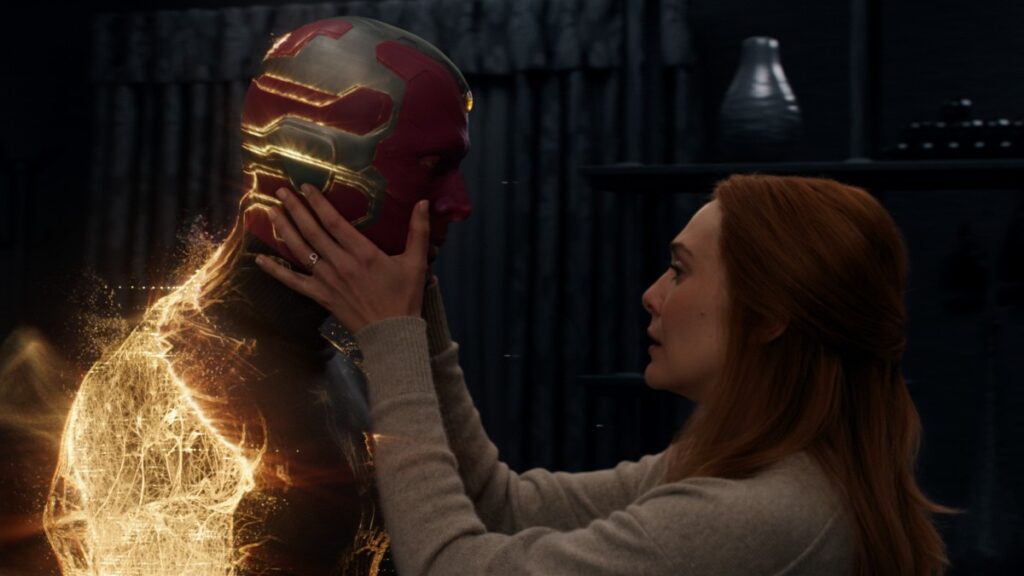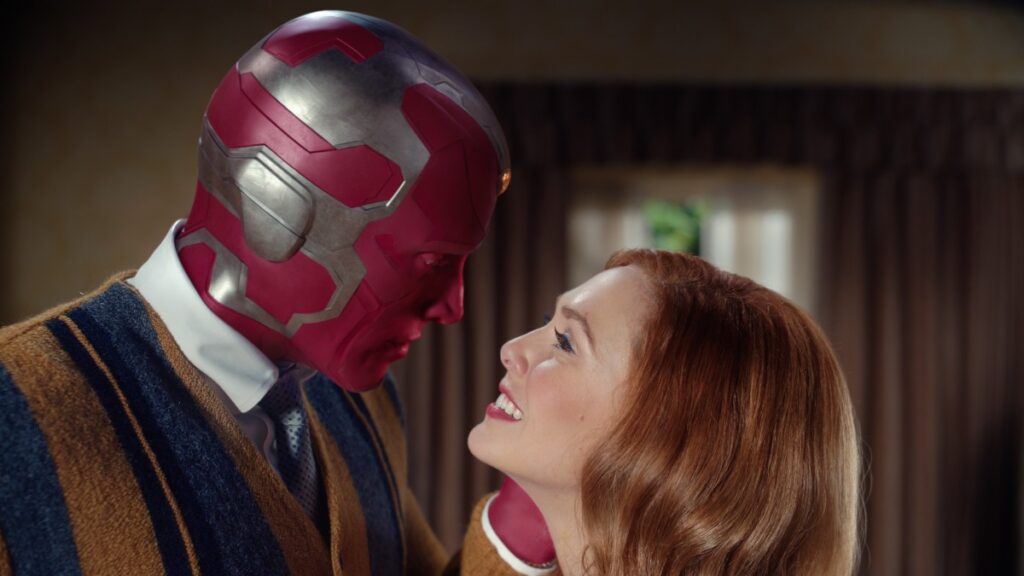
With the growing number of VFX-heavy television series and movies coming around, there’s a similarly growing and abundant need for more VFX houses to complete that work. It’s an industry that is booming.
Toronto’s MARZ (an acronym for “Monsters Aliens Robots Zombies) is one of the newer VFX studios in Toronto where shows like The Umbrella Academy and The Expanse have had some incredible visual effects done by MARZ’s talented team of artists to bring their fantastical worlds and characters to life.
MARZ’s latest project is one of the most talked-about series of 2021, Marvel Studios and Disney+’s WandaVision, starring Elizabeth Olsen and Paul Bettany as the eponymous Wanda and Vision, members of the popular MCU Avengers team. The series began with a number of black and white episodes that paid tribute to classic shows like The Dick Van Dyke Show and I Love Lucy, before it continued into color while still maintaining that concept. Few people watching the show realized that every scene that included Bettany as Vision was a VFX shot, plus there was more needed as the show went along.
MARZ worked on the Black and White Vision in the first two episodes, as well as other VFX in episode 101, as well as the full color Vision and his metamorphosis from human to android in four episodes and some floating Vision in episode 106.
As they say, it takes a village to make a show like WandaVision, and Below the Line spoke to MARZ Visual Effects Supervisor Ryan Freer about their part in bringing this popular series to life.
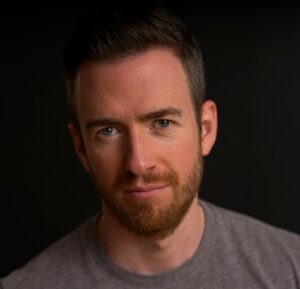
Below the Line: I tend to start by asking about background, since people in VFX all seem to have different backgrounds, so I’m curious about yours.
Ryan Freer: How far do you want me to go back? I originally went to school for character animation, and then my first job was at a motion graphics studio, where I kind of learned the ins and outs of motion graphics with my character animation. I learned compositing there as well, so I like to think of myself as kind of a glorified generalist. I’ve kind of done everything within the 3D landscape from animation to modeling, texturing, surfacing, lighting, tracking, and I’ve kind of done everything. It kind of makes sense that a supervisor was probably the end goal, and then here I am.
BTL: How long has MARZ been around?
Freer: MARZ has only been around for less than three years, but I’ve been in the industry now for just around 15 years. I actually met Lon [Molnar], who is the CEO and Co-Founder of MARZ, probably ten years ago? At least 10 years, maybe even 12 years ago. We rented some space in the basement there when he had his other company, Intelligent Creatures. It’s come around and now we’re working together with MARZ, and we’re doing big things, so it’s very cool. From a relationship that far back where we hadn’t worked really together since, it really is who you know within the industry. This industry is definitely huge.
BTL: How many animators do you have working there as full-time staff, or do you have people coming in for different projects as needed?
Freer: We staff up based on how many projects we have that need animation. Normally, we will have an animation supervisor, we’ll have a couple lead animators, a couple animators, I think, right now, we’re not as big as we were when we were right in the heat of WandaVision, but we’re ramping up for another big project that’s coming soon. So we’re looking to really grow that department quite, quite big in the next coming months.
BTL: How long ago did you get involved with WandaVision?
Freer: We did a test shot for them probably a year, year and a half ago, I would say. We took the basic tech that they had, which was the Vision head. That was the scan of him that ILM had, and we ingested into our pipeline, and we were able to turn around a test shot that was from Age of Ultron. It was one of the shots from it, we remade the shot. They were pretty impressed with that, and from that, we got awarded I think about 50 or 60 shots from the first episode. At that point, we had not done the black and white Vision. We didn’t know that he had a blue head. We didn’t know that we had to change a whole bunch of things with the rig and the head and how that would even look and change the compositing, everything changed going into the black and white Vision. But once we were able to get those 50-60 shots out the door, that’s when the door really opened up for the rest of the work on the show.
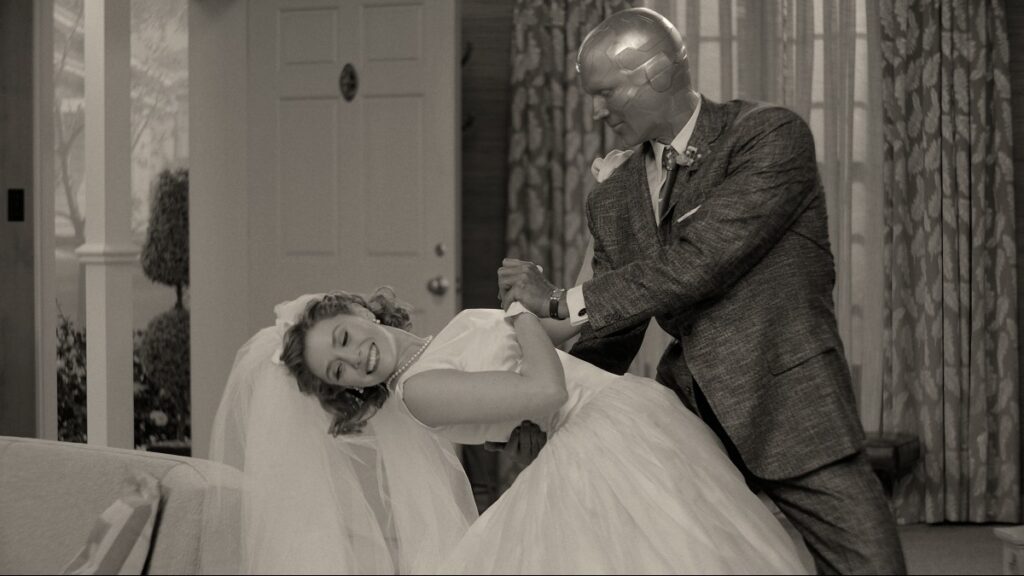
BTL: Is that common for a case like this where they have a character, they’ve already created in visual effects for a previous project for them to send it over as a starting point for a new VFX house?
Freer: I think if you’re using an asset from a previous season or previous movie, if it’s the same and it hasn’t really changed. Normally, at least the model would come over and normally, a studio doesn’t have the same tools on the rigging side internally. Normally, you have your own internal scripts and stuff like that, so we had to re-rig the head and what not, so yeah, that’s pretty normal.
BTL: Were you working on one episode at a time or were there things that you had to start earlier because it would take more work to finish?
Freer: I think because this was our first foray with Marvel and the show, they’re a very calculated crew, and they know what they’re doing. They didn’t want to overload or give us too much, and they wanted to see how we would perform on the first episode. I think we did really well. As we’re getting towards the end, they’re like, “Okay, here’s Episode Two,” and we’re getting towards the end of Episode Two, they’re like, “Okay, here’s Episode Three, here’s some for Four, and then we’re thinking about…“ While we’re working on it, I’ll be taking a look at what’s coming down the pipe and doing bids and sending the numbers over to them and making sure that everything was aligning. There’s some stuff you bid on, and just for timing or other vendors that are on the show, you don’t see it again. But that’s fine. There was more than enough work, I think, to go around for this show.
BTL: Obviously with a show that’s so VFX heavy, you’d have a lot of vendors but is it normal to have to bid on every shot or episode?
Freer: They know why you’re on the show, and we were on the show to do the head, they knew that we had a good grasp of it — it’s within our wheelhouse. We like to do characters, we like to do heads. We did the Watchmen work. We’re very strong at photoreal CG, especially within a scene. Like all the metal that’s on his head, you never think twice about all the reflections and lighting and surfacing that has to go into that. They knew what they wanted us for, and they would send us bid packages. Some of it would be a little bit outside of our scope or what we’ve done, and we’d throw some numbers at it. They would send us scenes saying, “Bid this scene, bid that scene,” so…
BTL: And these are in script form or do they have some graphics or visuals to work from?
Freer: Normally, we would have an Excel doc that would have the shots laid out by name and the work that’s needed, and then they would give us an edited reference for us to bid more accurately, a very early cut of the scene.
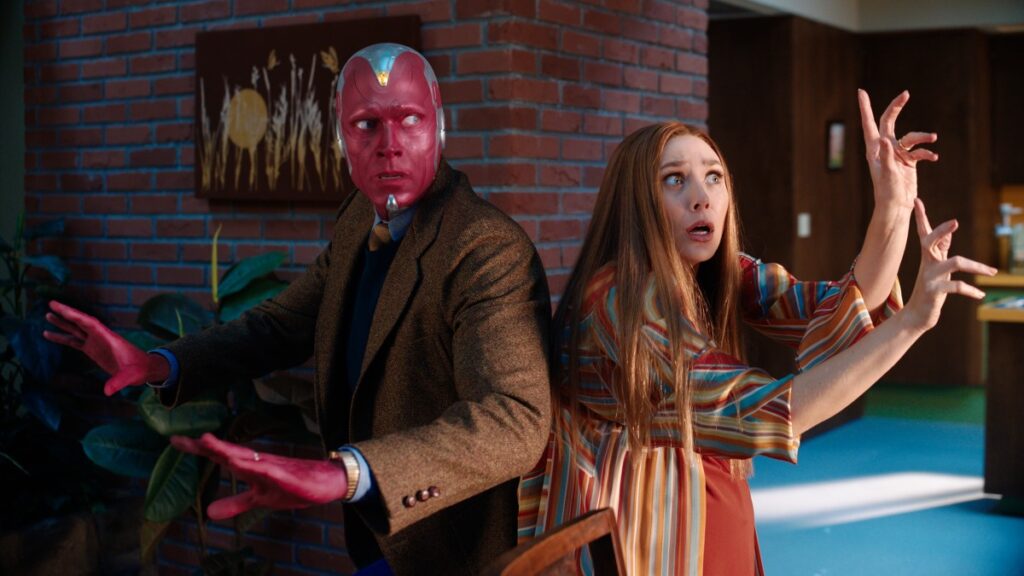
BTL: So they’d already shot some stuff at that point.
Freer: Yup, I mean, so that’s how we worked here. Sometimes, for whatever show is coming up or when we’re working on the next seasons of shows, they’ll send us a script, and we can give them some ballpark numbers, and we’ll get it into the place where they might be comfortable with it. At this point, it had already been shot.
BTL: When I spoke to Tara DeMarco, she told me about how Marvel auditioned the different vendors working on the show to pick each vendor for their strengths. I guess there’s a lot of conversation involved in that or is it like you said, you do 50 or 60 shots and go from there?
Freer: Yeah, that was like the gatekeeper episode for us, and they were nervous about the performance of Paul, because it’s a Vision we’ve never seen before. It’s very, very slapstick-y, very comedic, overacting, and they were worried how that would look. Because we overlay CG on top of his face, how would that hold up with his wild expressions, emulating that kind of era of TV shows. Once we did that, it opened the gate for the rest of the shows. Once we got into color, I loved doing the black and white Vision, but once we got into color, not that it wasn’t real before, but I couldn’t wait to get my hands on color Vision, because that’s how we all know and love him.
BTL: I think in the black and white episodes, I’m not sure how many people realize that there’s no CG involved. You assume it’s just on-set lighting. They didn’t actually shoot in black and white, did they?
Freer: No, they shot in color. We did all of our work in color just because when they apply that black and white LUT, at the beginning when they send it over to us, that’s not final until it’s finalized in color at the end. We did everything in color, everything was in blue, but we did have, like when we’re sending dailies back and forth to them to get approval, that black and white LUT was applied so that they could see how it was looking.
I mean, to your point, I would say the vast majority of people don’t know that they’re looking at CG when they’re looking at Vision. I went on a couple of Reddit message boards and people were wondering where all the budget went. I didn’t want to spoil it. I didn’t chime in or anything but I just listened to people, and I think there was one person that said, “I’ve heard that maybe they overlay some CG on him,” but no, everything is CG except for his eyes, his nose and his mouth. Everything. His ears are gone. Even when he’s wearing the cape and everything, you have to get all the way down into his chest and his trap muscles and everything, and we widen his neck out. It’s a lot of work, so every shot of Vision is a visual effect shot that has hit almost every department within MARZ.
BTL: Is Paul on set with any kind of tracking things for facial capture?
Freer: Yeah, so they used to put him in this headgear that gave him ear muffs, and I guess it was still early days on those first couple movies, and they just found that he couldn’t hear anybody. He couldn’t really hear himself. It pulled him out of the character, but now they totally paint him red or blue – blue being the black and white, red if not – and his ears stick out when he’s wearing a bald cap, so his hair is kind of tucked in which makes it a little bit easier on us when we have to go and trim in his whole face anyways to put the CG on top. Yeah, he’s got tracking markers all over his head, everywhere, all over his head, his neck, his face.
What’s really cool is for this project, we were able to use our ML team, our machine learning team, to create an AI script that could remove the tracking markers, so we didn’t have to go in and do all that paint work, which is pretty cool. A first for us and I haven’t heard of tracking marker removal within the industry for that specific use, especially for something like this. I don’t know if it’s a first or not, but it definitely helped save us time and saved us money, and it enabled us to do 400 shots with a much quicker turnaround, then a couple of shots than would be in a movie. There’s a lot more budget, a lot more time, and typically, you would hand paint all those tracking markers out, or they would be shipped to a vendor that would do it elsewhere for cheaper.
BTL: When you shifted to the color Vision, did you have to change a lot of what you were doing? I assume you had a way of seeing the black and white version while you were working on those episodes.
Freer: Like I said, I reviewed everything in black and white, but the color [version], that’s what got sent to Marvel so that when they could put the proper black and white color correct in DI. We went from a red head from the test to the blue head for the first couple of episodes, and then back to the red. Each time, we were tweaking textures and tweaking bump and displacement and specular on all the heads. Sometimes on a per shot basis where we have some shots where he’s very shiny, and he’s a little blown out. You can see that before you put the CG on, because we did match the lighting bang on. We have some of the most amazing lighters here. It would blow out, so we’d have to really dial that down before it would even go through lightning and then go to comp.
BTL: Do you have a lot of people there who are, like you say about yourself, generalists, who can handle different thing or are most of the people there specialists in one aspect of the work or another?
Freer: Not to say that a lot of people can’t do [multiple things], because we have so many talented people that they can’t jump on and do different things, but everyone pretty much stays in their department, at this point in time. For this show, just the amount of shots that we were just constantly pumping through, pumping through, like our tracking team was so strong, and they just kept everyone chugging along. Animation would pick up the shots, and they knew exactly what to do. Out of tracking, the head track animation would have to go and actually using like an onion skin, a transparency would go on top and match-move the animated face exactly to Paul’s face. All the little lines that are on his face, it’s CG, but they move exactly with his face, because we’ve done like a rotomation on it. Like I said, we just reveal the eyes and just the nose and a little bit of the mouth and everything else is CG.
BTL: Where was MARZ at when COVID hit? I’m pretty amazed how quickly a lot of VFX people were able to transition to home systems.
Freer: We were just starting off. I think we just had hit probably halfway through Episode One. I wouldn’t say it was a speed bump, but it was something we had to definitely…We had to evolve quickly with what was happening. At the end of the day, nobody was working locally on their machines, so everyone was remoting into their machine at the office. For the TPN network, which is the trusted partner network, that is how it has to be. There’s no other way. You can’t have files for a show on their local desktop. Everything needs to stay at the office. We were pretty safe, but now, the landscape is changing. We’re almost thinking this is going to be the norm for the industry.
BTL: So things aren’t getting back to normal where you’re slowly having more people back in the office yet?
Freer: Not yet, no, and we’re not there yet. I know you guys in the States got hit a lot harder than we did, but your vaccine roll-out plan…
BTL: It’s insane. I find it hard to believe when I see how many Americans or even New Yorkers have been vaccinated already.
Freer: You guys vaccinate more in a day than we have total. Yeah, you guys got hit a lot harder and we never had those huge case numbers. For us to be comfortable with people being back in that room together, we’re going to need to get the cases down, and I think the only way that’s going to happen is probably through vaccination, which is seemingly taking a lot more time.
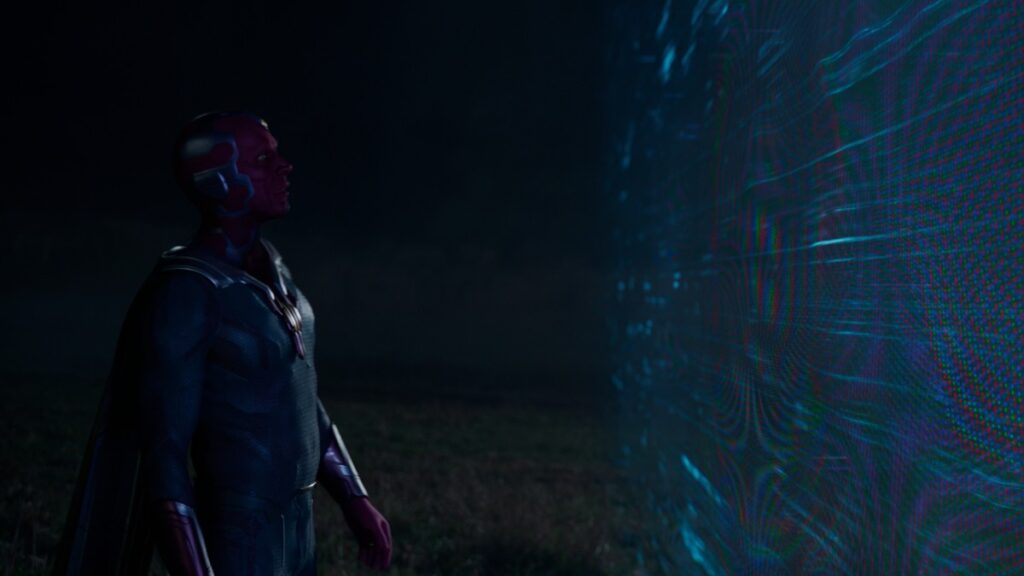
BTL: Although I’ve seen Watchmen, I have not seen some of the other shows MARZ has worked on like The Umbrella Academy and The Expanse, even though I have friends who rave about both shows. What should I look for of your work when I finally watch them?
Freer: So Umbrella Academy we did a lot of. For the Watchmen, we did Looking Glass, the guy with the metal sheath over his head, and for Umbrella Academy, we did a lot of Vanya and Harland powers, a lot of her, we did all sorts of stuff for that show, and that one’s coming back for another season, which is great. We can’t wait to get going on that, because it’s such an awesome show and so cool to be a part of that. The Expanse is shot here in Toronto, which is cool. Obviously, WandaVision wasn’t shot here, but it’s cool to work on shows that you know a lot of people working on them, whether they’re in VFX or not. It brings in a lot of work, and it’s cool.
BTL: I know VFX is probably a very competitive business, not just to get jobs in it, but also the competition between different VFX houses, but is there also some camaraderie where you all hang out in the same places and talk about what you’re all doing, or is that not done just because it’s so competitive?
Freer: I mean, there is and there isn’t. It’s hard to say. There’s so many people that have worked with each other at some point in time, and if someone’s leaving a company or going somewhere else, it’s always like, “Best of luck. I’m sure we’ll see each other around at some point in time.” There’s a lot of shows where you’re sharing assets between vendors, and it’s like, “Ooo, we need this, can you send that over?” It’s like, “Sure, we can send it over.” I think the more we work as a team, the better, but there doesn’t seem to be a shortage of work within Toronto right now. That’s why the shows have to go multi-vendor, because we couldn’t take all of Umbrella Academy, we couldn’t take all of WandaVision or shows like that. It’s good to find the vendors and pick what they’re good at and let them thrive there. Not all studios are specialized in the same thing.
BTL: Well, congratulations on all the great work you did on WandaVision, and I promise to get to some of those other shows soon. WandaVision is one of those shows you have to watch every week to keep up with the conversation so you’re not spoiled.
Freer: This is the first one that kicks everything off, and that’s why we were so stoked to be a part of it. It’s such a historic thing we think, not to mention the story is amazing, the directing is amazing. Like everything is just spot on. I don’t want to say it’s a TV show, but it pays such a homage to all the TV eras. It’s so cool to be a part of, and to be able to do those old effects that no one sees anymore nowadays, and to recreate those is really cool. So yeah, it was super fun.
WandaVision can now be watched via streaming on Disney+. You can also read our previous interview with Marvel Studios’ VFX Supervisor overseeing the series, Tara DeMarco here.
All pictures courtesy MARZ and Marvel Studios.

